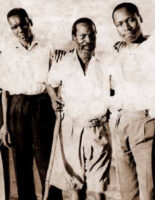
Kenyatta’s prison term at Lokitaung ended on April 14, 1959, and the restriction order passed by Thacker and confirmed by Baring in September 1954 was immediately applied.
He was moved to Lodwar, in Turkana, the administrative centre for the Northern Frontier District, some 90 miles ( 144km)from Lokitaung, where some bungalows had been built in readiness for the Kapenguria Six once their prison term ended. Kenyatta described the conditions here as a different type of imprisonment. He received a monthly allowance of six pounds and was allowed two hours of shopping in two specified Indian shops. During these excursions, he was not allowed to discuss politics with anyone. He described life at Lodwar as “a complete monotony, where heat and dust shout their hallelujahs daily”.
Their families could join them in Lodwar. A month or so after his arrival, he was joined by his third wife, Ngina, and his two daughters, whom he had not met since October 1952. The 1959 Christmas was a special occasion for Kenyatta as he was visited by his brother, James Muigai, and his daughter, Margaret Wambui.
Kenyatta was to spend two years in the heat trap of Lodwar.
Independence was beckoning as implied by British Prime Minister Harold McMillan, in the famous ‘wind of change’ speech in South Africa on February 3, where he stated: “The wind of change is blowing through this continent and whether we like it or not, this growth of political consciousness is a political fact and our national policies must take account of it.”
The death of 11 inmates at a camp of hardcore Mau Mau supporters in Hola on March 3, 1959 had already shamed Britain, as was stated by the Colonial Secretary lain Macleod – “Hola helped to convince that swift change was needed in Kenya” (Roseburg and Nottingham). At the Lancaster House Conference in January 1960, McMillan made it clear his intention was to give Africans majority rule in Kenya as soon as possible.
Kenya’s new governor, Sir Patrick Renison’s first headache was what to do with Kenyatta. To the Europeans, Kenyatta’s return was unthinkable. On March 31, 1960 Renison stated that Kenyatta’s release would be a danger to security. He later held a meeting with Macleod and on his return to Kenya, he reaffirmed his earlier stand on Kenyatta’s restriction .
In the eyes of many Kenyans, the release of Kenyatta and independence came together and the slogan of the day was ‘Uhuru and Kenyatta’. Kanu on their part vowed not to join government until Kenyatta was freed. On his part, Kenyatta advocated for unity among the Africans as a precursor to the attainment of independence.
Restriction in Maralal
On April 14, 1961 Kenyatta was flown out of Lodwar to Maralal in Samburu District. This marked what came to be known as the final stage of his exile. It was here that the Government decided that it was time for Kenyatta to again meet the world press as he had done eight years earlier on during the Kapenguria trial.
To many whites, Kenyatta symbolised the sinister forces conjured up by the words ‘Mau Mau’, hence measured him through the eye of the newsreel cameras against the Governor’s description of the ‘leader of darkness and death’. Dressed in his leather jacket and speaking English in a slow and controlled voice, he made it clear that he was speaking from a very disadvantaged position after eight years of being ‘bottled up’ in remote districts away from public life and world affairs. This was a time during which he had greatly been misrepresented by the media. He, therefore, urged them to stick to the truth and refrain from writing sensational and misleading stories.
Kenyatta was in Maralal for four months, during which time many leaders from various political parties, religious, racial communities and of world powers, lawyers, photographers, doctors, foreign visitors, friends and priests visited him. On their return, they all were assured of one thing, ‘Kenyatta was the man to safeguard their rights in an independent Kenya’. Maralal, therefore, offered Kenyatta the much needed build-up to his return to the political scene. Among his many visitors was Michael Blundell, whom he assured that he had no ill feeling for the Europeans and that the European farmers were key to the economic future of Kenya.
On August 14, 1961, Kenyatta was allowed to return to his home and his people.
After a week in restriction at Gatundu, Kenyatta met the Governor at the DC’s offices, where he received back his ring and black carved walking stick, signalling his final walk to freedom. This was followed by triumphal appearances throughout Kenya. He accepted the presidency of Kanu on October 28, 1961. On November 26, he was interviewed for BBC’s TV programme, Face to Face.
National Museums of Kenya, History Section.
